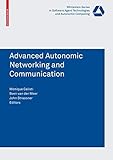Advanced Autonomic Networking and Communication / edited by Monique Calisti, Sven Meer, John Strassner.
Tipo de material: TextoSeries Whitestein Series in Software Agent Technologies and Autonomic ComputingEditor: Basel : Birkhäuser Basel, 2008Descripción: recurso en líneaTipo de contenido:
TextoSeries Whitestein Series in Software Agent Technologies and Autonomic ComputingEditor: Basel : Birkhäuser Basel, 2008Descripción: recurso en líneaTipo de contenido: - texto
- computadora
- recurso en línea
- 9783764385699
- QA76.9.C643
Springer eBooks
Architectures and Models -- Technology Neutral Principles and Concepts for Autonomic Networking -- A Telco Approach to Autonomic Infrastructure Management -- Modelling Behaviour and Distribution for the Management of Next Generation Networks -- Middleware and Services -- Autonomic Communication with RASCAL Hybrid Connectivity Management -- Autonomic Resource Regulation in IP Military Networks: A Situatedness Based Knowledge Plane -- Autonomic Service Access Management for Next Generation Converged Networks -- Networks -- Cross-layer Optimisations for Autonomic Networks -- An Autonomic MPLS DiffServ-TE Domain -- Game Theoretic Framework for Autonomic Spectrum Management in Heterogeneous Wireless Networks.
This book presents a comprehensive reference of state-of-the-art efforts and early results in the area of autonomic networking and communication. The essence of autonomic networking, and thus autonomic communications, is to enable the self-governing of services and resources within the constraints of business rules. In order to support self-governance, appropriate self-* functionality will be deployed in the network on an application-specific basis. The continuing increase in complexity of upcoming networking convergence scenarios mandates a new approach to network management. This Volume explores different ways that autonomic principles can be applied to existing and future networks. In particular, the book has 3 main parts, each of them represented by three papers discussing them from industrial and academic perspectives. The first part focuses on architectures and modeling strategies. Part two is dedicated to middleware and service infrastructure as facilitators of autonomic communications, and the last part addresses autonomic networks, specifically how current networks can be equipped with autonomic functionality and thus migrate to autonomic networks.
Para consulta fuera de la UANL se requiere clave de acceso remoto.


